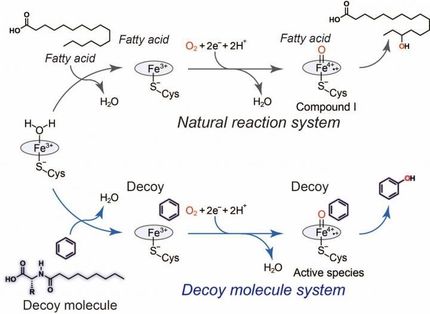Computing with Enzymes
Coupled enzyme systems are models for simple circuits
Advertisement
Computers are really very simply put together. They only understand two responses: yes or no, expressed as 1 or 0 in binary. Using logic operations, this can be used to program calculations and their results. Biological systems behave in a similar way: a stimulus acts on an ensemble of molecules, setting off defined chemical reactions. This analogy inspired I. Willner and his co-workers to use a combination of coupled enzymes to construct a simple circuit in which enzymatic reactions correspond to logic operations.
Glucose dehydrogenase (GDH) catalyzes the oxidation of glucose to gluconic acid while reducing NAD+ to NADH. Horseradish peroxidase (HRP) reduces hydrogen peroxide and consumes NADH, which is oxidized back to NAD+, closing the circuit. Addition of hydrogen peroxide (H2O2) or glucose is the input value, representing either 0 (no substance added) or 1. The resulting concentrations of NADH or gluconic acid can be determined photometrically and are the result of the enzymatic computational operation. The result value is either 0, meaning no change, or 1, meaning the absorption has been measurably changed. This can be used to simulate simple logic operations known as antivalence (XOR) and conjunction (AND). For the AND operation, the change in the gluconic acid concentration is measured: addition of H2O2 (input A) activates the HRP and NAD+ is produced. GDH uses this NAD+ to oxidize glucose (input B) to gluconic acid. If only glucose is added with no H2O2 (input A=0, input B=1), no NAD+ can be formed and the GDH cannot convert any glucose. If no glucose is added (input B=0), there is no substrate for the GDH reaction. In both cases no gluconic acid is formed. A result of 1, a measurable change in the absorption, only occurs when both H 2O2 and glucose are added. An XOR operation, in which the result is always 1 when inputs A and B are unequal, results when the change in the NADH absorption is measured after activation with either H 2O2 or glucose. If both are added, the glucose does cause NADH to be formed, but it is immediately used by the peroxidase in reducing the added H 2O2. Only addition of either H 2O2 or glucose causes the NADH absorption to change (result=1). If the logical elements AND and XOR are interconnected, the result is known as a half-adder, which can add two single-digit binary numbers. In the biological computer, this is accomplished by combination with two additional enzymes: glucose oxidase, which oxidizes glucose to gluconic acid and produces hydrogen peroxide, and catalase, which degrades hydrogen peroxide.
The researchers foresee the use of such enzyme-based computers as implantable devices that respond to metabolic pathways or follow complex drug therapies.
Original publication: I. Willner; "Elementary Arithmetic Operations by Enzymes: A Model for Metabolic Pathway Based Computing"; Angewandte Chemie International Edition 2006, 45, 1572.























































